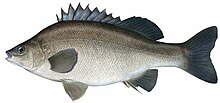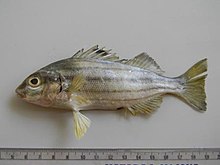Grunts
| Grunts | ||||||||||||
|---|---|---|---|---|---|---|---|---|---|---|---|---|

Three-striped tiger bass ( Terapon jarbua ) |
||||||||||||
| Systematics | ||||||||||||
|
||||||||||||
| Scientific name | ||||||||||||
| Terapontidae | ||||||||||||
| Vari , 1978 |
The Grunzbarsche (Terapontidae) are a family of perch relatives (Percomorphaceae). Most of the species inhabit the fresh and brackish waters of Australia , New Guinea , Indonesia and the Philippines . Some species also live as schooling fish in the sea.
features
The fish are 8.5 to 54 cm long. Their body is elongated to oval, slightly flattened on the sides. There are two spines on the gill cover , the lower one of which is longer. The ploughshare and palatine bone of most species do not have teeth. The number of Branchiostegal rays is six. The sideline extends to the caudal fin. The hard and soft rayed part of the dorsal fin are separated by an indentation. The soft-jet part can be laid down in a pit formed by scales. The pelvic fins stand just behind the base of the pectoral fin. The caudal fin is indented or rounded.
Fins formula : dorsal XI – XIV / 8–14, anal III / 7–12, ventral I / 5.
The swim bladder is divided transversely (along the longitudinal axis of the body). Paired muscles that attach to the outside of the anterior chamber of the swim bladder extend toward the back of the skull. With their help, the fish can make sounds. Grunts have 25 to 27 vertebrae.
Systematics
There are about 65 described species in 16 genera and some undescribed species in isolated rivers in the Australian Kimberley region .
-
Amniataba
- Amniataba affinis (Mees & Kailola, 1977) .
- Amniataba caudavittata ( Richardson , 1845) .
- Amniataba percoides ( Günther , 1864) .
- Amniataba sp. 1, Sale River
- Amniataba sp. 2, Pentecost River
- Amniataba sp. 3, Drysdale River
- Amniataba sp. 4, Fitzroy River
-
Bidyanus
- Bidyanus bidyanus (Mitchell, 1838) .
- Bidyanus welchi (McCulloch & Waite, 1917) .
-
Hannia
- Hannia greenwayi Vari, 1978 .
- Hannia wintoni Matthew C. Le Feuvre et al. 2016 .
-
Hephaestus
- Hephaestus adamsoni (Trewavas, 1940) .
- Hephaestus carbo (Ogilby & McCulloch, 1916) .
- Hephaestus epirrhinos Vari & Hutchins, 1978 .
- Hephaestus fuliginosus (Macleay, 1883) .
- Hephaestus habbemai (Weber, 1910) .
- Hephaestus jenkinsi (Whitley 1945) .
- Hephaestus komaensis Allen & Jebb, 1993 .
- Hephaestus lineatus Allen, 1984 .
- Hephaestus obtusifrons (Mees & Kailola, 1977) .
- Hephaestus raymondi (Mees & Kailola, 1977) .
- Hephaestus roemeri (Weber, 1910) .
- Hephaestus transmontanus (Mees & Kailola, 1977) .
- Hephaestus trimaculatus (Macleay, 1883) .
- Hephaestus tulliensis De Vis, 1884 .
-
Lagusia
- Lagusia micracanthus (Bleeker, 1860) .
-
Leiopotherapon
- Leiopotherapon aheneus (Mees, 1963) .
- Leiopotherapon macrolepis Vari, 1978 .
- Leiopotherapon plumbeus ( Kner , 1864) .
- Leiopotherapon unicolor (Günther, 1859) .
-
Mesopristes
- Mesopristes argenteus (De vis, 1884) .
- Mesopristes cancellatus ( Cuvier , 1829) .
- Mesopristes elongatus (Guichenot, 1866) .
- Mesopristes iravi Yoshino, Yoshigou & Senou, 2002 .
- Mesopristes kneri (Bleeker, 1876) .
-
Pelates
- Pelates octolineatus (Jenyns, 1840) .
- Pelates quadrilineatus ( Bloch , 1790) .
- Pelates sexlineatus ( Quoy & Gaimard , 1825) .
-
Pelsartia
- Pelsartia humeralis ( Ogilby , 1899) .
-
Pingalla
- Pingalla gilberti Whitley, 1955 .
- Pingalla lorentzi (Weber, 1910) .
- Pingalla midgleyi Allen & Merrick, 1984 .
-
Rhynchopelates
- Rhynchopelates oxyrhynchus ( Temminck & Schlegel , 1842) .
-
Scortum
- Scortum barcoo (McCulloch & Waite, 1917) .
- Scortum hillii ( Castelnau , 1878) .
- Scortum neili Allen, Larson & Midgley 1993 .
- Scortum parviceps (Macleay, 1883) .
-
Syncomistes
- Syncomistes bonapartensis Shelley et al., 2017 .
- Syncomistes butleri Vari, 1978 .
- Syncomistes carcharus Shelley et al., 2017 .
- Syncomistes dilliensis Shelley et al., 2017 .
- Syncomistes holsworth Shelley et al., 2017 .
- Syncomistes kimberleyensis Vari, 1978 .
- Syncomistes moranensis Shelley et al., 2017 .
- Syncomistes rastellus Vari & Hutchins, 1978 .
- Syncomistes trigonicus Vari, 1978 .
- Syncomistes versicolor Shelley et al., 2017 .
- Syncomistes wunambal Shelley et al., 2017 .
-
Terapon
- Terapon jarbua ( Forsskål , 1775) .
- Terapon puta ( Cuvier , 1829) .
- Terapon theraps (Cuvier, 1829) .
-
Variichthys
- Variichthys jamoerensis (Mees, 1971) .
- Variichthys lacustris (Mees & Kailola, 1977) .
About 40 of the described species and 13 genera occur in Australian waters. The numerous species developed, among other things, due to the frequent fluctuations in sea level and the associated isolation of individual populations ( allopatric speciation ) during the cold and warm periods in the Pliocene and Pleistocene .
literature
- Joseph S. Nelson : Fishes of the World , John Wiley & Sons, 2006, ISBN 0-471-25031-7
- Gunther Schmida: They are not cichlids: Australia's grunts . In DATZ 10/1998, ISSN 1616-3222
Individual evidence
- ^ A b Matthew C. Le Feuvre et al. 2016. Macroecological relationships reveal conservation hotspots and extinction-prone species in Australia's freshwater fishes . Global Ecology and Biogeography, vol. 25, no. 2, pp. 176-186; doi: 10.1111 / born 12397
- ↑ James J. Shelley, Stephen E. Swearer, Mark Adams, Tim Dempster, Matthew C. Le Feuvre, Michael P. Hammer, Peter J. Unmack: Cryptic biodiversity in the freshwater fishes of the Kimberley endemism hotspot, northwestern Australia. Molecular Phylogenetics and Evolution, June 25, 2018, doi: 10.1016 / j.ympev.2018.06.032
- ↑ James J. Shelley, Aurélien Delaval and Matthew C. Le Feuvre. 2017. A Revision of the Grunter Genus Syncomistes (Teleostei, Terapontidae) with Descriptions of Seven New Species from the Kimberley region, northwestern Australia. Zootaxa. 4367 (1); 1-103. DOI: 10.11646 / zootaxa.4367.1.1
- ↑ James J. Shelley, Stephen E. Swearer, Tim Dempster, Mark Adams, Matthew C. Le Feuvre, Michael P. Hammer, Peter J. Unmack (2020): Plio-Pleistocene sea-level changes drive speciation of freshwater fishes in north -western Australia. Journal of Biogeography, April 2020. doi: 10.1111 / jbi.13856
Web links
- Grunts on Fishbase.org (English)







